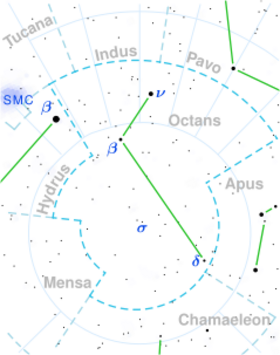Astronomy:Beta Octantis
| Observation data Equinox J2000.0]] (ICRS) | |
|---|---|
| Constellation | Octans |
| Right ascension | 22h 46m 03.51098s[1] |
| Declination | −81° 22′ 53.8120″[1] |
| Apparent magnitude (V) | 4.13[2] |
| Characteristics | |
| Spectral type | A9IV-V[3] |
| U−B color index | +0.11[4] |
| B−V color index | +0.20[4] |
| Astrometry | |
| Radial velocity (Rv) | +19.0±0.6[5] km/s |
| Proper motion (μ) | RA: −54.49[1] mas/yr Dec.: +1.16[1] mas/yr |
| Parallax (π) | 21.85 ± 0.43[1] mas |
| Distance | 149 ± 3 ly (45.8 ± 0.9 pc) |
| Absolute magnitude (MV) | +0.83[2] |
| Details | |
| Mass | 2.27[6] M☉ |
| Radius | 3.2[7] R☉ |
| Luminosity | 42[6] L☉ |
| Surface gravity (log g) | 4.15[8] cgs |
| Temperature | 8,006[8] K |
| Metallicity [Fe/H] | −0.02[9] dex |
| Rotational velocity (v sin i) | 49[6] km/s |
| Age | 496[8] Myr |
| Other designations | |
| Database references | |
| SIMBAD | data |
Beta Octantis, Latinized from β Octantis, is a probable astrometric binary[10] star system in the southern circumpolar constellation of Octans. It is faintly visible to the naked eye with an apparent visual magnitude of 4.13.[2] Based upon an annual parallax shift of 21.85 mas as seen from Earth, it is located about 149 light years from the Sun. It is moving away from the Sun with a radial velocity of +19 km/s.[5]
Based upon a stellar classification of A9IV-V,[3] the visible component is an evolving, white-hued A-type star with a spectrum that shows mixed traits of a main sequence and a subgiant star. It has an estimated 2.27[6] times the mass of the Sun and 3.2[7] times the Sun's radius. The star is around 500 million years old[8] with a projected rotational velocity of 49 km/s.[6] It is radiating 42[6] times the Sun's luminosity from its photosphere at an effective temperature of 8,006 K.[8]
References
- ↑ Jump up to: 1.0 1.1 1.2 1.3 1.4 Van Leeuwen, F. (2007). "Validation of the new Hipparcos reduction". Astronomy and Astrophysics 474 (2): 653–664. doi:10.1051/0004-6361:20078357. Bibcode: 2007A&A...474..653V. Vizier catalog entry
- ↑ Jump up to: 2.0 2.1 2.2 Anderson, E.; Francis, Ch. (2012). "XHIP: An extended hipparcos compilation". Astronomy Letters 38 (5): 331. doi:10.1134/S1063773712050015. Bibcode: 2012AstL...38..331A. Vizier catalog entry
- ↑ Jump up to: 3.0 3.1 Hoffleit, D.; Warren, W. H. (1995). "VizieR Online Data Catalog: Bright Star Catalogue, 5th Revised Ed. (Hoffleit+, 1991)". VizieR On-line Data Catalog: V/50. Originally Published in: 1964BS....C......0H 5050. Bibcode: 1995yCat.5050....0H.
- ↑ Jump up to: 4.0 4.1 Mallama, A. (2014). "Sloan Magnitudes for the Brightest Stars". The Journal of the American Association of Variable Star Observers 42 (2): 443. Bibcode: 2014JAVSO..42..443M.Vizier catalog entry
- ↑ Jump up to: 5.0 5.1 Gontcharov, G. A. (2006). "Pulkovo Compilation of Radial Velocities for 35 495 Hipparcos stars in a common system". Astronomy Letters 32 (11): 759–771. doi:10.1134/S1063773706110065. Bibcode: 2006AstL...32..759G.
- ↑ Jump up to: 6.0 6.1 6.2 6.3 6.4 6.5 Zorec, J.; Royer, F. (2012). "Rotational velocities of A-type stars". Astronomy & Astrophysics 537: A120. doi:10.1051/0004-6361/201117691. Bibcode: 2012A&A...537A.120Z. Vizier catalog entry
- ↑ Jump up to: 7.0 7.1 Allende Prieto, C.; Lambert, D. L. (1999). "Fundamental parameters of nearby stars from the comparison with evolutionary calculations: Masses, radii and effective temperatures". Astronomy and Astrophysics 352: 555–562. Bibcode: 1999A&A...352..555A. Vizier catalog entry
- ↑ Jump up to: 8.0 8.1 8.2 8.3 8.4 David, Trevor J.; Hillenbrand, Lynne A. (2015). "The Ages of Early-Type Stars: Strömgren Photometric Methods Calibrated, Validated, Tested, and Applied to Hosts and Prospective Hosts of Directly Imaged Exoplanets". The Astrophysical Journal 804 (2): 146. doi:10.1088/0004-637X/804/2/146. Bibcode: 2015ApJ...804..146D. Vizier catalog entry
- ↑ Gontcharov, G. A. (2012). "Dependence of kinematics on the age of stars in the solar neighborhood". Astronomy Letters 38 (12): 771–782. doi:10.1134/S1063773712120031. Bibcode: 2012AstL...38..771G. Vizier catalog entry
- ↑ Eggleton, P. P.; Tokovinin, A. A. (September 2008). "A catalogue of multiplicity among bright stellar systems". Monthly Notices of the Royal Astronomical Society 389 (2): 869–879. doi:10.1111/j.1365-2966.2008.13596.x. Bibcode: 2008MNRAS.389..869E.
 |


